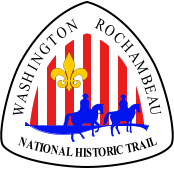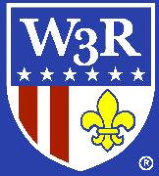


Washington - Rochambeau National Historic Trail




The W3R
®
in Delaware
The King's Highway (now called the Philadelphia Pike) was the main East Coast communications route, and it served the patriots well. Entering Delaware near the Robinson House the route passes through Wilmington, becomes Newport Pike, the Stanton- Christiana Road, and Baltimore Pike. In September of 1781 Delaware farmers brought meat, wheat, and hay to Wilmington for the armies that were moving south. Spirits (and prices) were high since the 4,000 well-armed French (three times Wilmington's population] paid in silver for their purchases. Re-enactors of French troops, Newport RI 2006 Many amphibious row-galleys carried Continental troops and artillery to Christiana, were drawn overland to Elkton, and then launched on Chesapeake Bay. Soon Delawareans celebrated the victory at Yorktown. Afterwards, heading back north, both the Continental Army camped in Delaware, and the French in 1782. From 1782 to 1783, over 600 French troops and 300 horses of Lauzun's Legion called Wilmington home for five months.Historical Overview
Throughout the Revolutionary War, Delaware was a critical overland link in the transport of troops and materials between the Chesapeake Bay and the Delaware River, so as to avoid exposure to the British warships patrolling the Atlantic coastal waters. It was during their travel through Delaware, that the Continental and French officers and troops first learned that the British navy had been prevented from rescuing Cornwallis from Yorktown. The Americans knew then, that victory was almost certain. The British were cut off from supplies and reinforcements. The British were unlikely to be relieved by a rescue force, and the British were outnumbered by over four to one. In September, 1781, columns of French troops marched down Philadelphia Pike while hundreds of Continental Army troops rowed barges with the U.S. artillery down the Delaware River. Two thousand French troops set up tents in Wilmington. There were twice as many troops as townspeople. Farmers from as far as fifty miles away drove wagons full of supplies to Wilmington to supply food for the troops and feed for the horses and oxen. The French paid in silver for their purchases.






